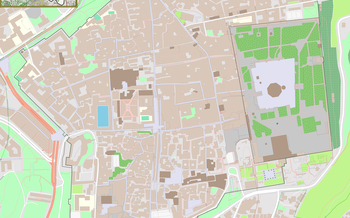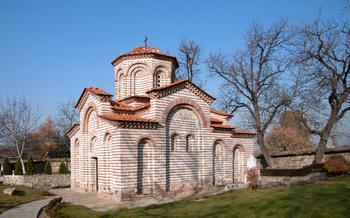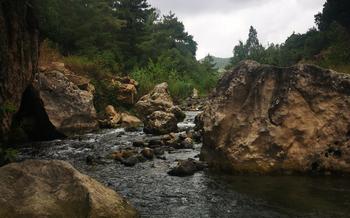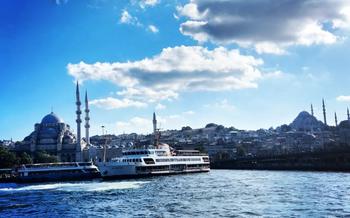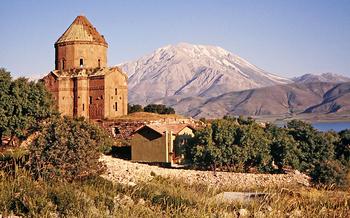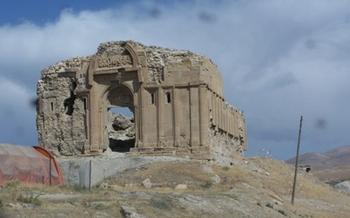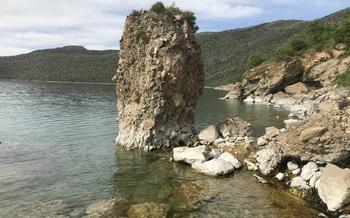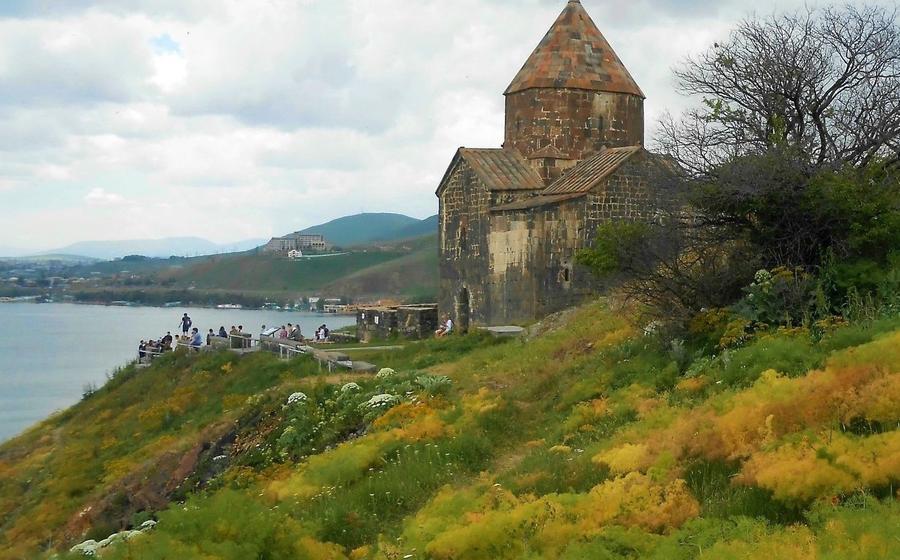
Sevan Monastery
- Van's Religious History
- Location and Access
- Historical Background
- The Monastery Complex
- Surviving Frescoes
- Monastery's Decline and Abandonment
- Recent Discoveries and Excavations
- The Surrounding Landscape
- Local Legends and Folklore
- Visiting the Monastery Today
- Photography and Videography
- Cultural Significance and Symbolism
- Nearby Attractions
- Ethical Considerations
- Insider Tip
Van's Religious History
Van's religious history is rich and diverse, with the Sevan Monastery serving as a testament to the region's Christian heritage. The monastery played a crucial role in spreading Christianity in the region, and its architectural beauty and historical significance make it a must-visit destination for anyone interested in the history of religion in Turkey.
Christianity's influence in Van dates back to the early centuries of the Common Era, when missionaries from the Armenian Apostolic Church began to spread the faith in the region. The Sevan Monastery was founded in the 9th century and quickly became one of the most important centers of Christianity in Van. The monastery's location on an island in Lake Van provided a natural fortress, protecting it from attack and allowing it to flourish as a center of learning and spirituality.
The monastery's significance extended beyond its religious role. It was also a center of culture and education, with a renowned scriptorium where manuscripts were copied and illuminated. The monks of Sevan Monastery also played a vital role in preserving the Armenian language and culture during periods of persecution and assimilation.
In addition to the Sevan Monastery, Van is home to several other important religious sites. The city's Armenian Cathedral, built in the 19th century, is a testament to the enduring presence of Christianity in the region. The city also has several mosques, including the Ulu Mosque, built in the 16th century, which is one of the oldest and most significant mosques in Turkey.
Location and Access
The Sevan Monastery, an architectural marvel nestled amongst the mountainous landscapes of Van, is situated approximately 25 kilometers northeast of the city center. Accessible by road, visitors can embark on a scenic drive through picturesque villages and rugged terrain. The well-maintained roads offer a smooth journey, leading directly to the monastery's doorstep. Ample parking spaces are available for travelers to conveniently leave their vehicles and immerse themselves in the serene ambiance of the site.
Historical Background
The Sevan Monastery's origins trace back to the 9th century when it was established by the Armenian Apostolic Church. The construction of the monastery complex is attributed to Bishop Sargis, who played a pivotal role in spreading Christianity throughout the region. The architectural style of the monastery reflects Armenian ecclesiastical architecture, characterized by its cruciform design, domed roofs, and intricate stone carvings. The monastery's strategic location on a hilltop overlooking Lake Van made it a prominent religious and cultural center in the region. It served as a sanctuary for Armenian Christians, providing a safe haven for religious practices and fostering a deep sense of community among its inhabitants.
The Monastery Complex
The Sevan Monastery, an architectural marvel, comprises several structures that offer a glimpse into its rich history and spiritual significance. The main church building, the heart of the complex, boasts an impressive dome and intricate stone carvings depicting biblical scenes and symbolic motifs. Inside, visitors can marvel at the well-preserved frescoes that adorn the walls and ceiling, narrating stories from the Bible and the lives of saints.
Beyond the main church, the monastery complex encompasses several chapels, each dedicated to a specific saint or purpose. These chapels feature unique architectural elements and decorative details, reflecting the diverse influences that shaped the monastery's construction. Bell towers, with their graceful spires reaching towards the heavens, once resonated with the sound of bells calling the faithful to prayer.
The living quarters, where monks resided and conducted their daily activities, provide insights into the monastic way of life. Modest cells, arranged around courtyals, exude an atmosphere of tranquility and devotion. Communal areas, such as the refectory and the library, served as gathering places for monks to share meals, study religious texts, and engage in spiritual contemplation.
Surviving Frescoes
The Sevan Monastery is renowned for its stunning and well-preserved frescoes, which are considered masterpieces of medieval Armenian art. These intricate paintings cover the walls and ceilings of the main church and other structures within the complex, depicting scenes from the Bible, the lives of saints, and historical events.
The frescoes are executed in a variety of styles, ranging from naturalistic to symbolic, and display a remarkable level of artistry and craftsmanship. The vibrant colors and expressive figures bring the stories to life and offer a glimpse into the beliefs and worldview of the medieval Armenian community.
While some of the frescoes have suffered from the effects of time and neglect, many remain in relatively good condition, thanks to recent conservation efforts. Visitors can admire the beauty and symbolism of these artistic treasures, which provide a unique and valuable insight into the religious and cultural heritage of the region.
The frescoes at the Sevan Monastery are not only of artistic value but also serve as important historical documents, providing valuable information about the development of Armenian art and the influence of Byzantine and Persian styles. They are a testament to the skill and devotion of the medieval Armenian artists who created these magnificent works of art.
Monastery's Decline and Abandonment
The Sevan Monastery, once a thriving center of Christianity in the region, faced a gradual decline in the centuries that followed its construction. Various factors contributed to its eventual abandonment. Political turmoil, religious persecution, and economic hardships took their toll on the monastery and its community.
One of the significant factors in the monastery's decline was the rise of Islam in the region. As the influence of Christianity waned, the monastery faced increasing pressure from Muslim rulers and communities. This led to restrictions on religious practices and the imposition of heavy taxes on Christian institutions. The monastery's income dwindled, making it difficult to maintain its buildings and support its monks.
Another factor contributing to the monastery's decline was the Mongol invasion of the region in the 13th century. The Mongols, known for their destructive campaigns, raided and plundered the monastery, causing significant damage to its structures and loss of valuable artifacts. The monastery never fully recovered from this devastating blow.
Over time, the monastery's isolation and remoteness also played a role in its abandonment. With the decline of the surrounding Christian population, the monastery became increasingly isolated and vulnerable to attacks from nomadic tribes and bandits. The lack of resources and support from the local community made it challenging to maintain the monastery and sustain its activities.
As a result of these combined factors, the Sevan Monastery was eventually abandoned by its monks. The once-vibrant religious center fell into disrepair and ruin, its buildings left to the mercy of time and the elements. The monastery's abandonment marked a significant loss for the local Christian community and left a void in the region's religious and cultural heritage.
Recent Discoveries and Excavations
In recent years, the Sevan Monastery has become the focus of renewed interest and archaeological research. Excavations conducted at the site have unearthed a wealth of artifacts and relics that shed light on the monastery's history and its role in the spread of Christianity in the region.
Among the most significant discoveries are fragments of pottery, coins, and jewelry that date back to the monastery's early days. These artifacts provide valuable clues about the daily lives of the monks and the economic activities that took place within the monastery complex.
Furthermore, archaeologists have uncovered several well-preserved tombs and burial chambers within the monastery grounds. These burials contain the remains of monks and other individuals associated with the monastery, offering insights into their funerary practices and beliefs.
The ongoing archaeological work at the Sevan Monastery has the potential to reveal even more secrets about this ancient site. Future excavations may uncover additional structures, artifacts, and inscriptions that will help us better understand the monastery's history and its role in the development of Christianity in the region.
The Surrounding Landscape
The Sevan Monastery is nestled amidst a breathtaking natural landscape that adds to its allure. Majestic mountains, lush forests, and serene lakes paint a picturesque backdrop for this ancient sanctuary. The surrounding region offers a plethora of opportunities for nature enthusiasts and outdoor adventurers.
The towering peaks of the Van Mountains provide a dramatic backdrop to the monastery, inviting hikers and climbers to embark on exhilarating trails. The verdant forests that carpet the slopes offer a tranquil escape, where visitors can immerse themselves in the soothing sounds of nature.
For those seeking a more leisurely experience, a stroll along the shores of nearby Lake Van offers stunning views of the monastery and its environs. The lake's crystal-clear waters and serene ambiance create an idyllic setting for a peaceful retreat.
In addition to hiking, climbing, and lakeside strolls, the area surrounding the Sevan Monastery offers a variety of other outdoor activities. Visitors can embark on horseback riding excursions, explore the region on mountain bikes, or simply bask in the tranquility of their surroundings.
Local Legends and Folklore
The Sevan Monastery is deeply embedded in local legends and folklore, passed down through generations of Van's inhabitants. One captivating tale revolves around a hidden treasure believed to be buried within the monastery's walls. According to legend, a wealthy Armenian merchant, fearing persecution, concealed his vast riches within the monastery, entrusting its safekeeping to the monks. Despite numerous attempts to uncover the treasure, it remains elusive, fueling the imaginations of locals and visitors alike.
Another legend tells of a secret tunnel connecting the monastery to nearby Lake Van. It is said that during times of danger, the monks could escape through this hidden passageway, seeking refuge on the lake's remote shores. The existence of this tunnel has never been confirmed, but its allure persists, adding to the mystique of the monastery.
These legends and stories are not merely fables; they are an integral part of the monastery's cultural significance. They reflect the deep connection between the monastery and the local community, weaving a rich tapestry of history, faith, and imagination.
Visiting the Monastery Today
The Sevan Monastery stands as a testament to history, inviting visitors to explore its ancient ruins and immerse themselves in the spiritual atmosphere. While its grandeur has faded over time, the monastery's charm remains palpable, offering a glimpse into the region's rich past.
Currently, the monastery is open to visitors, providing an opportunity to walk through its crumbling walls and experience the serenity of the surroundings. Although the site is not fully restored, its historical value and unique ambiance make it a worthwhile destination for anyone interested in history, architecture, or religion.
To fully appreciate the monastery's significance, consider booking a guided tour led by a local expert. These tours offer insights into the monastery's history, architecture, and religious importance, enhancing the overall experience.
While visiting the monastery, remember to be respectful of its religious significance and maintain proper conduct. Dress modestly, avoid loud noises, and refrain from touching or damaging any artifacts or structures.
Plan your visit during the summer months, typically from June to September, to enjoy pleasant weather and avoid the harshness of winter. Additionally, check the monastery's official website or contact local authorities for any special events or exhibitions that may be taking place during your visit.
Photography and Videography
The Sevan Monastery offers ample opportunities for capturing stunning photographs and videos. The ancient architecture, intricate frescoes, and picturesque surroundings provide a visually captivating backdrop for creative expressions. However, it's essential to approach photography and videography at the monastery with respect and sensitivity.
Guidelines for Responsible Photography
-
Respect the sanctity of the site: Remember that the monastery is an active place of worship for many Christians. Be mindful of ongoing religious ceremonies and avoid disturbing or disrupting them.
-
Obtain permission: Before taking photographs or videos inside the monastery, seek permission from the caretaker or a local authority. This ensures that you comply with any specific regulations or restrictions.
-
Use discretion: While capturing images, be discreet and avoid using flash photography, which can damage the delicate frescoes and artifacts.
-
Preserve the authenticity: Strive to capture the monastery's essence without altering or staging scenes. Authenticity is key to preserving the historical and cultural value of the site.
Permits and Regulations for Commercial Use
If you intend to use your photographs or videos for commercial purposes, such as publication or sale, it's essential to obtain the necessary permits and clearances. Contact the local authorities or the Armenian Apostolic Church to inquire about the specific requirements and procedures.
By following these guidelines and regulations, you can contribute to the preservation and appreciation of the Sevan Monastery while capturing its beauty and significance through your lens.
Cultural Significance and Symbolism
The Sevan Monastery stands as a potent symbol of the enduring Armenian heritage, reminding visitors of the region's rich Christian history. It is deemed a sacred site, a testament to the faith and beliefs of the Armenian people. As a result, the monastery has acquired tremendous cultural and religious significance, serving as a beacon of Armenian identity and a source of pride for the local Christian community.
Efforts to promote religious tolerance and foster interfaith dialogue are pivotal in the context of the Sevan Monastery. This historical and cultural landmark represents a shared heritage, encouraging mutual understanding and respect among people of different faiths. It offers a unique platform for interfaith learning and dialogue, fostering a sense of harmony and coexistence within the diverse religious landscape of the region.
Nearby Attractions
In the vicinity of the Sevan Monastery, history and nature intermingle to offer a rich tapestry of experiences. Akdamar Island, a picturesque landmass nestled within Lake Van, boasts the magnificent Church of the Holy Cross, an architectural marvel dating back to the 10th century. Its intricate carvings and frescoes captivate visitors with their beauty and historical significance.
Hosap Castle, perched atop a hill overlooking the city of Van, is another must-see attraction. This ancient fortress, with its sturdy walls and commanding presence, offers breathtaking panoramic views of the surrounding landscape. Explore its ruins and immerse yourself in the tales of its past, where it stood as a formidable defense against invaders.
History buffs will delight in the Van Museum, home to an extensive collection of artifacts that tell the story of the region's diverse cultural heritage. From ancient pottery to medieval manuscripts, the museum provides a fascinating glimpse into the rich tapestry of civilizations that have shaped this land.
For those seeking outdoor adventures, Mount Suphan, the highest peak in the region, beckons with its challenging slopes and breathtaking vistas. Embark on a trekking journey to conquer its summit and be rewarded with panoramic views that stretch as far as the eye can see.
Combining a visit to the Sevan Monastery with these nearby attractions allows travelers to create a comprehensive itinerary that encompasses history, culture, nature, and adventure. Each destination offers its unique charm and perspective, painting a vivid portrait of the region's diverse offerings.
Ethical Considerations
When visiting the Sevan Monastery, it is important to be mindful of the religious significance of the site and to behave respectfully. This means dressing modestly, avoiding loud noises or disruptive behavior, and refraining from taking photographs or videos of people without their permission. It is also important to be aware of the local customs and traditions, and to respect the privacy and beliefs of the local community.
Visitors should also be mindful of the impact of their visit on the local environment. This means staying on designated paths, avoiding littering, and being careful not to damage the fragile ecosystem. It is also important to support local businesses and communities by purchasing souvenirs and services from local vendors. By doing so, visitors can help to preserve the cultural heritage of the region and ensure that the benefits of tourism are shared by all.
Insider Tip
Visiting the Sevan Monastery during the off-season (late autumn to early spring) offers a unique and serene experience. The crowds are fewer, allowing you to immerse yourself in the tranquility and history of the site without distractions. The cooler temperatures provide a comfortable climate for exploring the monastery grounds and the surrounding natural beauty.
While in the area, don't miss the opportunity to savor the local cuisine. Van is renowned for its delicious dishes, particularly its grilled meats, fresh trout from nearby lakes, and traditional sweets. Indulge in a culinary journey by sampling local specialties at family-run restaurants or cozy cafes.
For a truly memorable experience, consider embarking on a hot air balloon ride over the stunning landscapes of Van. This unique perspective offers breathtaking views of the monastery and its surroundings, creating an unforgettable memory of your visit.
